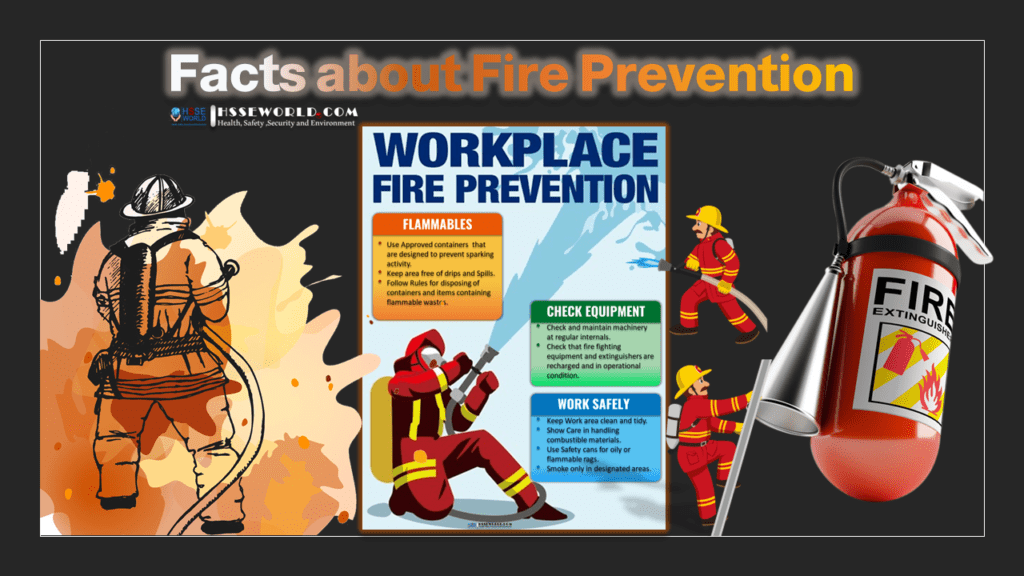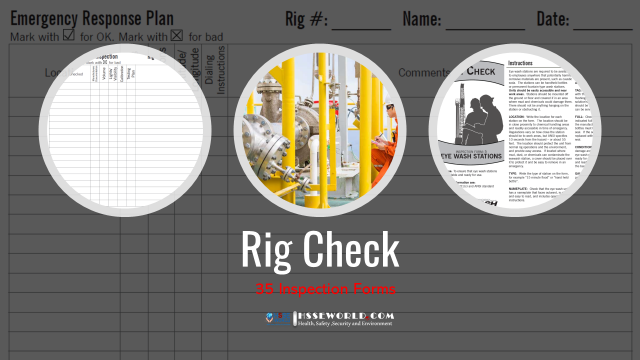Fire can race through a structure in a matter of minutes, threatening the lives of that inside and leaving a devastating impact on businesses. Every year in the United States, the Bureau of Labor Statistics reports on the frequency of work-related fatalities and nonfatal injuries due to fires or explosions.
To have Fire Prevention Plan or Program Use these tips to avoid workplace fires or explosions :
- Avoid storing or stockpiling flammable materials, such as packaging materials or waste, both inside and outside business premises.
- Make sure all machinery is kept clean and properly serviced.
- If possible, turn machinery off when not in use or when the business is closed.
- Install a suitable fire alarm system, such as a remotely serviced alarm system, sprinkler system, or thermal or smoke alarm, and test and service the system routinely.
- If your business stores dangerous chemicals or materials, use and store them in accordance with federal, state, and local requirements.
- Make sure all employees and responsible parties are trained in your fire prevention, evacuation, and contingency plans.
Also Read .Fire safety for office workers.

Fire Prevention Plans
Under the Occupational Safety and Health Administration’s 29 Code of Federal Regulations 1910.39, employers must create a fire prevention plan. Employers with 10 or fewer employees may communicate the plans orally. Employers with 11 or more employees must have plans that are:
- in writing,
- kept in the workplace, and
- available for employees to review.
The plan must list:
- all major fire hazards on site;
- proper handling and storage procedures for hazardous materials;
- potential ignition sources and their control;
- types of fire protection equipment needed to control each major hazard;
- procedures for controlling the buildup of flammable and combustible waste materials;
- procedures for regularly inspecting, maintaining, and testing safeguards installed on heat-producing equipment to prevent accidental ignition of combustible materials;
- job titles of employees responsible for maintaining equipment to prevent or control sources of ignition or fires; and
- job titles of employees responsible for controlling fuel-source hazards.
Download: Books: Fire Safety Logbook templates
Contingency Plans
Know what your organization would need to stay in business after a fire. Create a contingency plan to protect and restore important hard-copy and electronic information, like supplier and client lists, business contracts, and insurance details. Your plan should include a designated, secure, off-site location for storing the information, and a person who is responsible for maintaining and updating the information.
Video: Fire Prevention & Response
Smoke Alarms
Contact the local fire department to determine your building’s fire alarm requirements. Smoke alarms or smoke detectors should be installed on every level of a building, including the basement, ceilings, or high walls.
Test smoke alarms and smoke detectors once a month according to the manufacturer’s instructions. Replace batteries once a year or as soon as the smoke alarm or smoke detector chirps to indicate that the battery is low. Replace smoke alarms – even those that are hard-wired or have long-life batteries – every 10 years. Have a qualified electrician install hard-wired fire alarms.
Also Read: Fire and Gas detection system and types of Fire and Gas Detectors
Evacuation Plans
In addition to maintaining smoke alarms, businesses should develop and practice a basic fire evacuation plan so employees know what to do when an alarm sounds. Employers should involve as many people as practical in putting together the plan. As part of the plan, have employees:
- a study posted evacuation plans,
- learn two ways out of each work area,
- count the number of desks or workstations between their work area and the nearest two exits,
- designate people responsible for helping employees with temporary or permanent mobility limitations;
- designate an outside meeting place where everyone can gather after they’ve evacuated,
- have a system to account for everyone in the building,
- go to training when they are first hired and every year after, and
- practice the evacuation plan at least twice a year.
Also Read:
Fire Extinguishers
A portable fire extinguisher can quickly put out a small fire or control a larger one until the fire department arrives. If portable fire extinguishers are part of your business’s emergency plan, provide the right type and an adequate number of extinguishers, mount them in readily accessible locations, and regularly recharge and inspect them.
Employees chosen and trained to use a fire extinguisher must know how to operate it before a fire breaks out. Employees should only operate a fire extinguisher if they have a clear escape route and are comfortable handling the situation. They should start using the extinguisher 6 to 8 feet away from the fire and then move closer as the fire shrinks. To use a fire extinguisher, remember the word “PASS” while holding the extinguisher with the nozzle pointing away from you:
- Pull the pin;
- Aim low, pointing the extinguisher at the base of the fire;
- Squeeze the lever; and
- Sweep the nozzle from side to side.
Also Read: Fire Extinguisher Classification Meaning
Fire Sprinkler Systems
Properties with an automatic fire sprinkler system have an 87 percent lower death rate for every 1,000 reported than properties without an automatic extinguishing system. Sprinklers also help reduce injury rates and average property losses per fire.
To keep a sprinkler system effective, check the system’s control valves, air, and water pressure as required; protect sprinkler heads with metal guards if exposed to potential physical damage; and maintain proper clearance below sprinkler heads. Assign the task of testing and maintaining the sprinklers to a sprinkler contractor or other designated person.
Also Read: Templates: Fire Sprinkler Maintenance Program
Other Fire Suppression Systems
While automatic sprinkler systems work by spraying water toward detected heat and fire, other fixed fire suppression systems work by filling areas – like areas that have important electrical equipment – with gas or chemical agent to quickly put out the fire before it causes damage.
OSHA’s Fire Extinguishing Systems General Standard 29 CFR 1910.160 regulates any fixed system, regardless of why it was installed, that could expose employees to injury, death, or negative health risks due to these extinguishing agents.
All employers with a fixed extinguishing system installed to meet a particular OSHA standard – except automatic sprinkler systems, which are covered by 29 CFR 1910.159 – must comply with the standard. (Systems installed in areas where employees are not potentially exposed to an extinguishing agent are exempt.)

The “fire extinguishing standard” outlines general requirements as well as standards for the specific type of extinguishing agent being used: dry chemical (29 CFR 1910.161), gaseous agent (29 CFR 1910.162), and water spray and foam (29 CFR 1910.163). Fixed fire extinguishing system components and agents must be designed and approved for use on the specific fire hazards they are expected to control or extinguish.
To keep employees safe when using automatic fire suppression systems – particularly the total flooding type that can reduce oxygen and create toxic atmospheres – employers must properly operate and regularly maintain and test the systems. Key requirements include:
- inspecting each system annually;
- making sure systems are always turned on except during repairs or maintenance;
- telling employees what measures to follow if the system breaks, and having defects fixed by trained personnel;
- training, and retraining as needed, the designated employees who inspect, maintain, operate, or repair the systems; and
- for areas protected by total flooding systems, which work by filling an enclosed space with carbon dioxide, Halon 1211, or other agents that pose a serious health hazard:
- posting warning signs at the entrances to these areas, and
- providing an emergency action plan in accordance with 29 CFR 1910.38 to give employees a safe way to evacuate.
Also Read: 6 Common Fire Sprinkler Myths
Download Workplace Fire Prevention Infographic
Please visit our Safety Resources SAFETY BAG to have many Safety Resources





